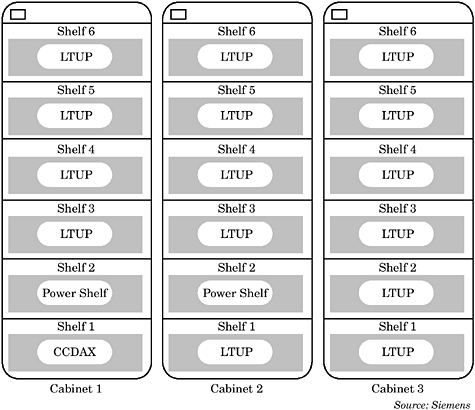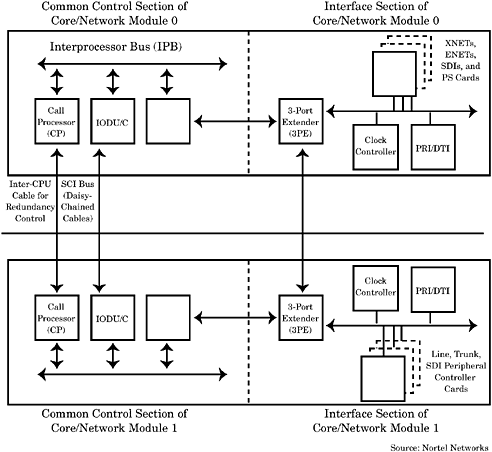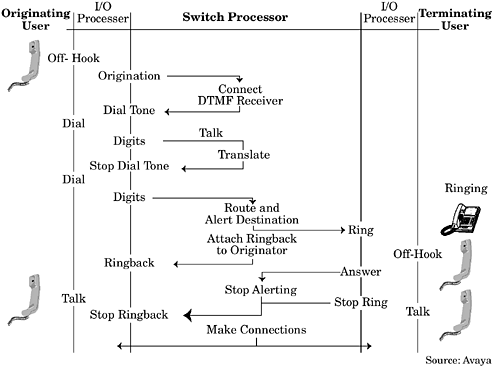A PBX cabinet or a single carrier may support one or more of the following functions.
Control
The control carrier contains printed circuit board slots that house specific control circuit cards or modules supporting processing and memory functions. A single circuit pack may include processor and memory chips. Additional circuit cards may include tone clocks, maintenance and diagnostic circuit packs, auxiliary equipment circuit packs, and a variety of expansion interface boards for system designs with multiple cabinets and/or stackable carriers. An expansion interface board may be used to link to a duplicated control carrier shelf in a fully redundant common control complex design or to other cabinet carriers, such as switching network, port, and application carriers. Tone clock and maintenance and diagnostic functions may be embedded in the processor/memory circuit pack in very small system designs. The control carrier shelf is equipped with one or two local power supply modules, if a centralized power supply carrier shelf is not included in the design.
Switching
The switching carrier contains printed circuit board slots that house switch network circuit cards or modules. The switch network circuit cards or modules may support center stage switching or local TDM bus functions. Switch network function may be embedded on the processor/memory circuit pack in small system designs. For a dedicated switching carrier shelf expansion, interface boards are also required to provide control and signaling links to the control carrier and TDM bus transmission links to expansion port carriers/cabinets. A dedicated switching carrier shelf is equipped with one or two local power supply modules, if a centralized power supply carrier is not included in the design. The Definity G3r ECS Switch Node Interface Carrier is an example of a dedicated switch carrier (Figure 1).

Port
The port carrier contains printed circuit board slots that house port interface circuit cards. There are a variety of port interface cards supporting the many types of station and trunk peripherals. Some port carrier shelves may also support application circuit packs/modules. A maintenance/diagnostics circuit pack may also be supported on the carrier shelf. The carrier shelf is also equipped with one or two local power supply modules, if a centralized power supply carrier is not included in the design. Port carriers typically support between 16 and 20 port circuit card slots, although some PBX system model port carriers may support fewer or more slots. The number of port card slots has remained relatively constant during the past 15 years, although port circuit card density (port terminations per card) has increased significantly. The Definity G3si/r ECS Port Carrier is an example of a dedicated port carrier (Figure 2).

Auxiliary
A dedicated auxiliary carrier/cabinet is available as a common equipment option and typically available only with large PBX system designs. Auxiliary equipment housed in the carrier/cabinet may include call accounting systems, recorders, announcers, paging systems (loudspeaker, code calling), and music-on-hold. Small and intermediate PBX system designs may support some of these functions with the use of circuit packs housed in the control carrier shelf. Local power supply modules power the carrier/cabinet.
Application
Application carriers contain printed circuit board slots that house circuit card packs/modules dedicated to specific system applications, such as system administration, messaging (voice, integrated, unified), or call center (processing, reporting). The carrier shelf or cabinet is also equipped with one or two local power supply modules, if a centralized power supply carrier is not included in the design. The industry design trend has been to use an adjunct server cabinet, instead of an integrated application carrier/cabinet, to support advanced optional application requirements. The early adjunct server options were linked to the PBX common equipment via a proprietary cable, but the more common current method is a TCP/IP-based Ethernet LAN interface. The first adjunct server cabinet options were usually limited to a single applica- tion. Current adjunct servers now support multiple application software programs. For example, the Siemens HiPath AllServe 150 applications server supports system administration, ACD, messaging, and call accounting.
Power
The power carrier distributes power from the main power distribution to the PBX common equipment components. Dedicated power carriers are usually available with large systems only. Based on the port size configuration and number of port cabinets, more than one power carrier may be required.
A very small or small PBX system may have a cabinet design based on a single multifunction carrier that supports the functions mentioned above. In this type of PBX cabinet design, all the basic control, switching, and port interface boards are housed in a single carrier sharing a common backplane, including power converters distributing current to the provisioned circuit cards. Intermediate line size systems are more typically based on stackable carrier or multicarrier cabinet designs that include a control/switching carrier and one or more expansion carriers. Each carrier shelf in an intermediate/large system design would include power supply modules. The control/switching carrier may also support a limited number of port interface card slots for customers with limited station/trunk requirements at system installation to minimize upfront common equipment requirements. Large/very large PBX system models are commonly designed with dedicated carriers for control and/or switching functions. These dedicated control/switch carriers do not support port interface cards, which are housed in dedicated port carriers/cabinets.










